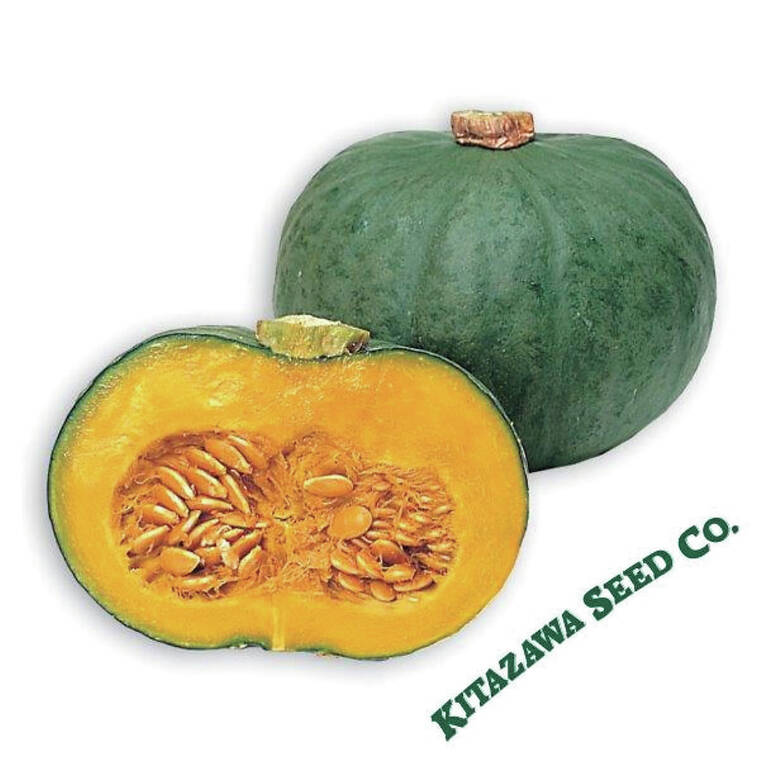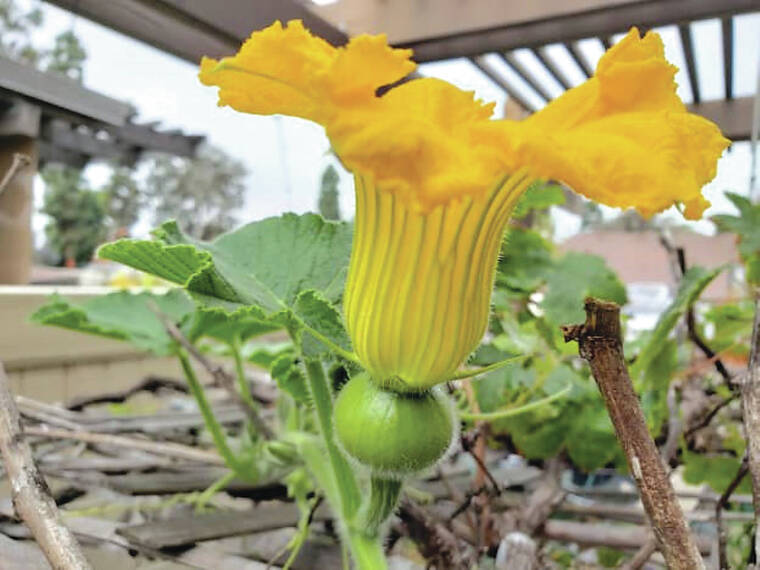Plant of the month – October 2023 – kabocha squash

The blue kuri kabocha cultivar is among several different seed varieties offered by the Asian seed company Kitazawa based in Oakland, Calif. (Courtesy photo/kitasawaseed.com)

A winter sweet kabocha grown from Johnny’s Seeds has a gray-green skin and a very sweet flavor. (Courtesy photo/johnnyseeds.com)

The dark green leaves and yellow flowers of the kabocha squash plant make it an attractive addition to your edible garden. (Courtesy photo/growertoday.com)

When the kabocha flower dies and falls off, it is time to bag or otherwise protect your squash from insects like the pickle worm. (Courtesy/photo)

Kabocha fruit begins forming at the base of female flowers. (Courtesy photo/dengarden.com)
The autumn equinox occurred last Friday night meaning we are officially into fall. This season often conjures visions of fields of orange pumpkins for me. Memories of times past. Here in Hawaii, the best pumpkin to grow is the Japanese kabocha squash. It is green, not orange, but is easy to grow and has very tasty orange flesh.
The autumn equinox occurred last Friday night meaning we are officially into fall. This season often conjures visions of fields of orange pumpkins for me. Memories of times past. Here in Hawaii, the best pumpkin to grow is the Japanese kabocha squash. It is green, not orange, but is easy to grow and has very tasty orange flesh.
Though you may not have the mature fruit by this year’s holiday season, this is a squash that can be prepared in numerous ways throughout the year. If you have a bit of room in your garden for a wandering squash plant, consider growing kabocha.
This winter-type squash has a tough outer shell that makes it less vulnerable to disease or insect attack than softer-shelled summer squashes like zucchini or yellow crookneck. Those are best grown in screen houses but kabocha doesn’t need that protection.
As a member of the Cucurbitaceae or gourd family, kabocha is known botanically as Cucurbita moschata. Carbon dating of these squash seeds found in archaeological sites in New Mexica show it was grown there as long ago as 3400 B.C. Though the plant was probably first domesticated in parts of South or Central America, it made it to many other locales over time.
It is the kabocha cultivar developed in Japan that is most frequently grown here. It was probably introduced to Japan in the late 1500s by Portuguese sailors, though the Chinese may also have introduced some varieties at around the same time.
While several different kabocha varieties have been developed, all have a sprawling, low-growth habit. They all have yellow trumpet-shaped flowers and produce round, dark-green to gray-green fruit. Most kabochas have deep lobes and some cultivars have light-colored spots or stripes on the tough outer skin. All varieties have bright orange flesh that has a delicious, sweet taste.
Growing kabocha from seed is easy. You can take fresh seeds from a squash with a taste that you like or you can buy the seeds. The seeds are large, between a ½ to 1 inch long and should be buried at about the same depth in soil. A rich soil or a seeding or potting mix with good drainage is an ideal medium for squash seeds.
You can plant them in a container and plant them out when the plants develop their first few true leaves and are at least 4 inches long. Since the seeds germinate quickly and grow rapidly, seeding directly in the garden can also work well.
Kabocha plants will do best in a full sun location in a friable soil that drains well. Watering several times a week at first is recommended where there is little rainfall. As the plants become established, they need less water and will continue to do well if watered deeply about once a week. You can control the sprawling growth habit a bit by training the plant into a more confined space. They do send out feeder roots at nodes along the stem, so move the stems carefully to avoid damaging these roots.
Kabocha plants will grow and produce well with regular feeding. Fertilizing lightly during the first month of growth with a well-balanced, organic product will encourage stem growth as well as flowering and fruiting.
Fertilizing again once fruit formation begins is also advised.
Within six to eight weeks after germination the plants will likely start producing large yellow blossoms, which are either male or female. Once the female flowers are pollinated, the fruit will begin forming as the flower drops off. You can look for recipes using the flowers, but you may limit fruit production if you pick female flowers.
During flowering, be sure to inspect your plants frequently to ensure that they are not being attacked by the pickleworm. The caterpillar is clear to white with black spots and feeds on the flowers and fruit of many plants in the cucurbit family including kabocha squash. The adult is a small night-flying moth with yellow wings with purple borders. She lays tiny eggs that develop into hungry pickle worm caterpillars. The eggs are usually laid at the blossom end of the fruit evidenced by a tiny hole there. The best cure is prevention. Bag the young squash or cover it with nylon stockings to keep the moth from laying her eggs on your kabocha. Bacillus thuringensis, or BT, is a safe and effective way to kill the caterpillars but once they are inside the squash, it won’t help.
Watch for diseases on your kabocha leaves and treat appropriately as soon as you see problems. To avoid problems, do not overwater, grow in soil with good drainage and in an area with good air flow.
You should be able to start picking mature fruit in around three months, depending on soil, water, nutrition and weather conditions. Mature fruit is usually dark green and may be as large as 20 inches in diameter. When the squash is mature, the stem dries a bit and turns brown. At this point, the fruit is ready to pick but should be “cured” off the vine for several weeks to develop the full, sweet flavor characteristic of kabocha squash.
Storage in a dry place between 65 and 75 degrees for up to three months actually increases the carbohydrate content as well as refining the flavor.
Kabocha is a nutritious and a delicious vegetable. It is rich in fiber as well as beta carotene, iron, potassium and vitamin A and C. The entire fruit is edible, including the seeds. Baking, boiling or steaming the fruit either whole or cut into pieces prepares it for eating. It is a wonderful vegetable on its own or as an ingredient in soups, stews or curries.
The seeds are also edible. Roasted squash seeds, known as pepitas, are popular in Latin America. They are washed, oiled and seasoned to become a healthy and tasty snack after about 30 minutes in the oven. Of course, you can always save the seeds and share with friends so that you can all grow more kabocha squash.
I highly recommend growing this vegetable as a nutritious and delicious addition to an edible garden. Buy a squash and save the seeds or look for them at local nurseries or garden stores. They are also available online through many different seed companies.
Gardening Events
Saturdays:
• “Work Day at Amy Greenwell Garden” from 9 a.m. to 12:30 p.m. Meet at the Garden Visitor Center across from the Manago Hotel in Captain Cook. Come with a mask and prepared to practice social distancing. Volunteers can help with garden maintenance and are invited to bring a brown bag lunch. Water and snacks provided. Visit the website www.amygreenwell.garden/get-involved/volunteer-1/ and sign up for the weekly email for more information on work days.
Thursday, Friday, Saturday, October 5-7:
• “33rd Annual Hawaii Tropical Fruit Growers Conference” starting at 8 a.m. on Oct. 5 going to 2 p.m. on Oct. 7 at Blaisdell Center in Honolulu. Topic: “Security Starts with the Soil”. More information at https://www.htfg.org/event-details/33rd-annual-htfg-conference-1
Save the dates:
October 17, deadline to apply: •“Emergency Conservation Program” applications due to help address damages from wildfires and high winds. Contact UH CTAHR in Kona for more information.
October 17-18 •“Malama the Farmer” at the Grand Naniloa Hotel in Hilo. Oct. 17 breakout sessions,
October. 18
•Agricultural businesses tour. Registration $225 for both days. Sponsorships available for farmers. Sponsored by UH CTAHR and Western Region Agricultural Stress Assistance Program. More information at AgrabilityTraining and Events or contact Agrability Partners Tess McKeel at tmckeel@goodwillfingerlakes.org or JoBeth Rath at jbrath@goodwillfingerlakes.org.
Saturday, Oct. 21: •“Coffee, Tea, Water: Essential Elements Expo” from 9 a.m. to 5 p.m. at the Na‘alehu Sports Park. Free Admission. Hosted by Stargazer Industries to celebrate the elements we cherish. Music and food will also be available.
Farmer Direct Markets
(Check websites for the latest hours and online markets)
Wednesday:
• “Ho‘oulu Farmers Market” 9 a.m. to 2 p.m. at Sheraton Kona Resort &Spa at Keauhou Bay
Saturday:
• “Keauhou Farmers Market” 8 a.m. to noon at Keauhou Shopping Center. Information on their online market: keauhoufarmersmarket.com/onlinemarket
• “Kamuela Farmer’s Market” 7:30 a.m. to noon at Pukalani Stables
• “Waimea Town Market” 7:30 a.m. to noon at the Parker School in central Waimea
• “Waimea Homestead Farmers Market” from 7:30 a.m. to noon at the Waimea middle and elementary school playground
Sunday:
• “Pure Kona Green Market” 9 a.m. – 2 p.m. at Amy Greenwell Garden in Captain Cook
• “Hamakua Harvest” 9 a.m. to 2 p.m. at Hwy 19 and Mamane Street in Honokaa
Plant Advice Lines
Anytime: konamg@hawaii.edu
Tuesdays and Thursdays: 9 a.m. to noon at UH-CES in Kainaliu — 322-4893 or walk in.
Mondays, Tuesdays anad Fridays: 9 a.m. to noon at UH CES at Komohana in Hilo — 981-5199 or himga@hawaii.edu
Diana Duff is a plant adviser, educator and consultant living part time in Kailua-Kona.


